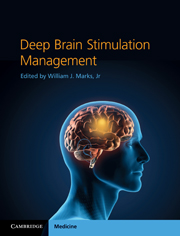Crossref Citations
This Book has been
cited by the following publications. This list is generated based on data provided by Crossref.
Katz, Evgeny
2014.
Implantable Bioelectronics.
p.
435.
Katz, Evgeny
2015.
Implantable biofuel cells operating in vivo: Providing sustainable power for bioelectronic devices: From biofuel cells to cyborgs.
p.
2.
Parastarfeizabadi, Mahboubeh
and
Kouzani, Abbas Z.
2017.
A Miniature Low-Power Multi-Biomarker-Based Brain Sensor for Closed-Loop DBS.
IEEE Sensors Journal,
Vol. 17,
Issue. 10,
p.
3109.
Bondarenko, Viktor
Kholyavin, Andrey
Belyaev, Yaroslav
Epifanov, Dmitry
Bzhikhatlov, Islam
Abramchuk, Mikhail
and
Mokeyev, Maxim
2020.
Development of a 6-axis Robotic Manipulator for Stereotactic Surgery.
p.
1.
Shamrey, Vladislav
Abritalin, Evgeny
Kholyavin, Andrey
Korzenev, Arkadiy
and
Peskov, Viktor
2020.
Modern functional stereotactic neurosurgeric methods in treatment of neurological and mental disorders.
Vestnik nevrologii, psihiatrii i nejrohirurgii (Bulletin of Neurology, Psychiatry and Neurosurgery),
p.
9.
Neudorfer, Clemens
Elias, Gavin J B
Jakobs, Martin
Boutet, Alexandre
Germann, Jürgen
Narang, Keshav
Loh, Aaron
Paff, Michelle
Horn, Andreas
Kucharczyk, Walter
Deeb, Wissam
Salvato, Bryan
Almeida, Leonardo
Foote, Kelly D
Rosenberg, Paul B
Tang-Wai, David F
Anderson, William S
Mari, Zoltan
Ponce, Francisco A
Wolk, David A
Burke, Anna D
Salloway, Stephen
Sabbagh, Marwan N
Chakravarty, M Mallar
Smith, Gwenn S
Lyketsos, Constantine G
Okun, Michael S
and
Lozano, Andres M
2021.
Mapping autonomic, mood and cognitive effects of hypothalamic region deep brain stimulation.
Brain,
Vol. 144,
Issue. 9,
p.
2837.
Wong, Joshua K.
Hilliard, Justin D.
Holanda, Vanessa M.
Gunduz, Aysegul
Wagle Shukla, Aparna
Foote, Kelly D.
and
Okun, Michael S.
2021.
Time for a New 3-D Image for Globus Pallidus Internus Deep Brain Stimulation Targeting and Programming.
Journal of Parkinson's Disease,
Vol. 11,
Issue. 4,
p.
1881.





